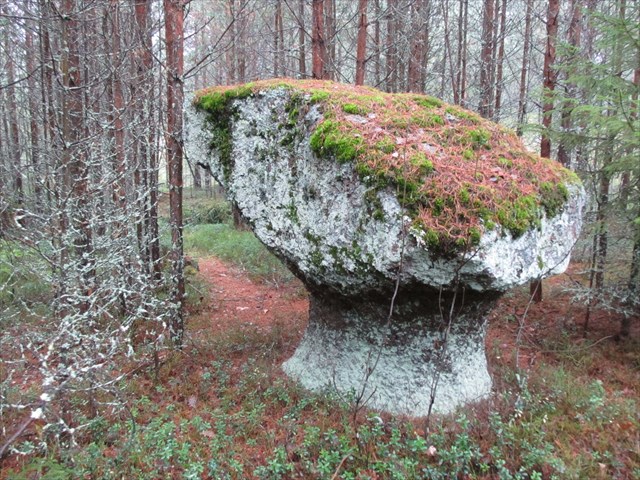CHANTERELLE ROCK

Chanterelle Rock consists of viborgite which is a coarse-grained rapakivi granite. Viborgite's main minerals are potash feldspar, quartz, plagioclase, black mica and hornblende.
Characteristic of rapakivi granite are roundish alkali feldspar megacrysts, or ovoids, which are enclosed in a greyish plagioclase feldspar rim. However not all granites that can be classified as rapakivi granite contain alkali feldspar ovoids. If the rapakivi structure is well developed, the rapakivi granite is called viborgite.
Finland's bedrock is usually very hard, so stack formation is extremely rare. Rapakivi (a reddish form of granite that easily crumbles, hence its Finnish name) and porphyritic granodiorite, by contrast, are so soft that ice, waves, acid lake water and temperature fluctuations can corrode these two types of stone. Weathering is the crumbling of a cliff or other rock. There are two types of weathering: mechanical and chemical. Mechanical weathering can be for example when water freezes in cracks in the rock, it can be fracturing caused by the embrittling effect of the sun and fracturing caused by plant roots. Chemical weathering can be among others the dissolving of softer rock types in water and thus the disintegration of the rock, and the effect of different salts and acids on rock. Thus, sea-stacks occur in at least a score of locations in Finland.
A sea-stack or stack is a column, mushroom or bridge-shaped rock formation resulting from weathering. The softer rock material has been worn away from around the stack. It can be on a modern or prehistoric shoreline or shore boulder. Stacks in Finland were formed after the last ice age and are of three types: 1, marine stacks formed by coastal forces (waves, tides, currents); 2, lake stacks formed by shoreline forces on lakeshores; 3, river stacks on river banks alongside rapids, which are also eroded by ice flows after the winter. The oldest existing stacks began forming around 11,500 to 12,500 years ago. Stacks are still being formed today.
The English name of "stack" is derived from the word "stakkur" in Faroese (the language spoken in the Faroe Islands), while the Finnish term "raukki" comes from the ancient Scandinavian "rauk", which means (rather aptly) a "stone statue standing on the shore".
CHANTERELLE

1. Describe the terrain where the chantarelle rock is located and determine on the spot if it is part of the bedrock or just a stone. Explain.
2 .Determine whether the stack is still being formed, and if so, how.
3. How large in diameter are the largest ovoids in the Chanterelle Stone?
4. What was the prevailing climate like during the forming of this stack?
5. What was the name of the sea or lake that started moulding the stack?
6. How high is the stack above today's sea level?
Send your answers to me via my profile and wait for permission to log. Unauthorised logs will be deleted.
|